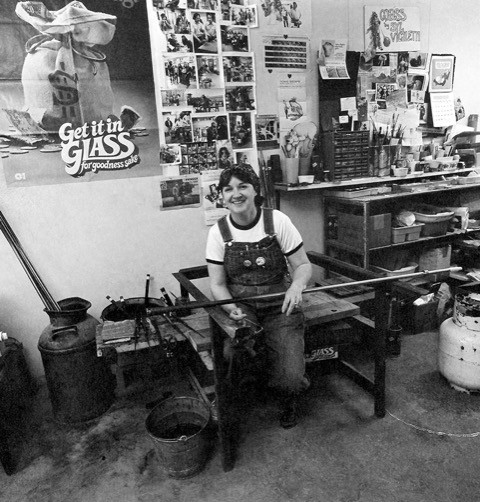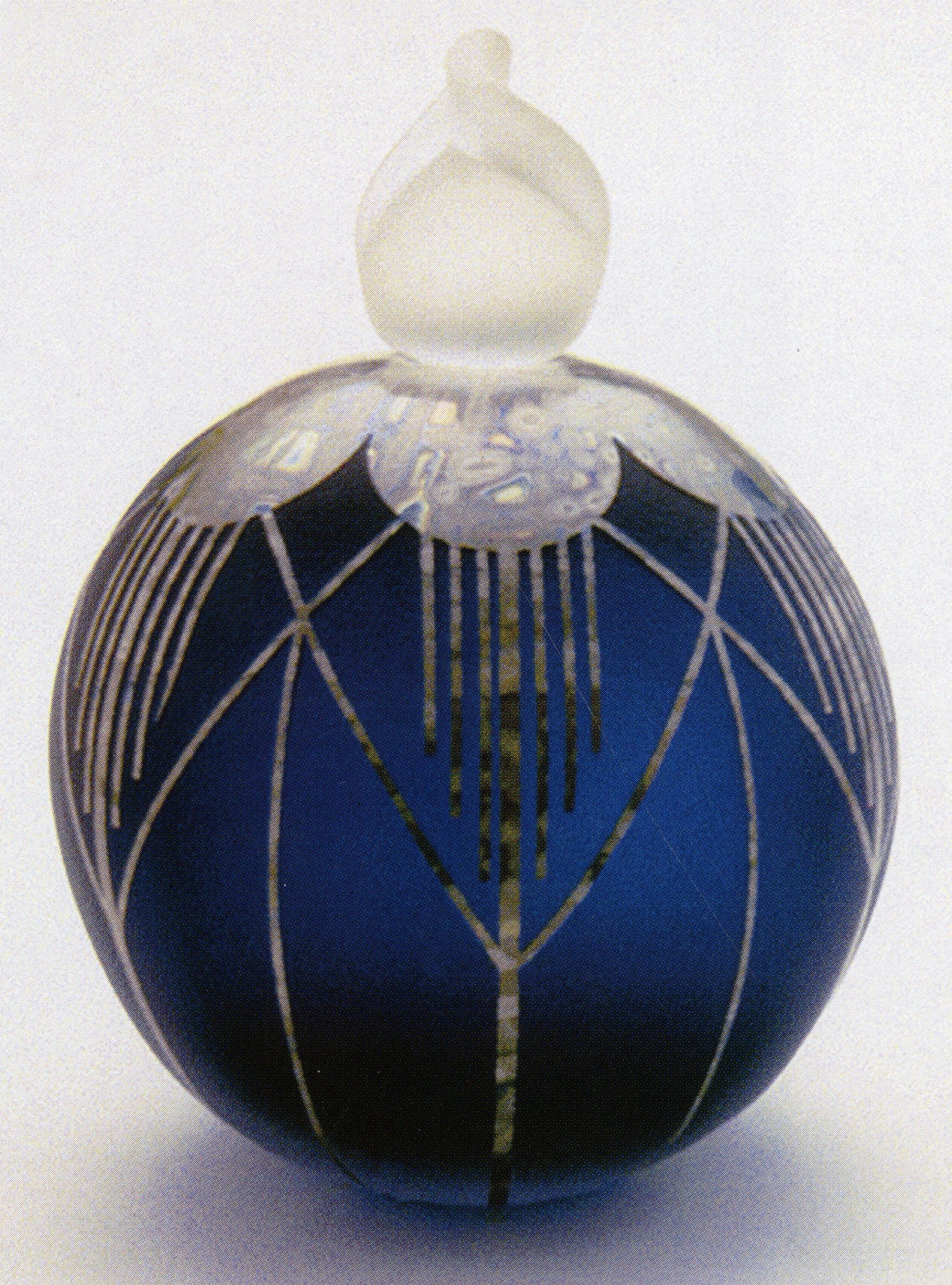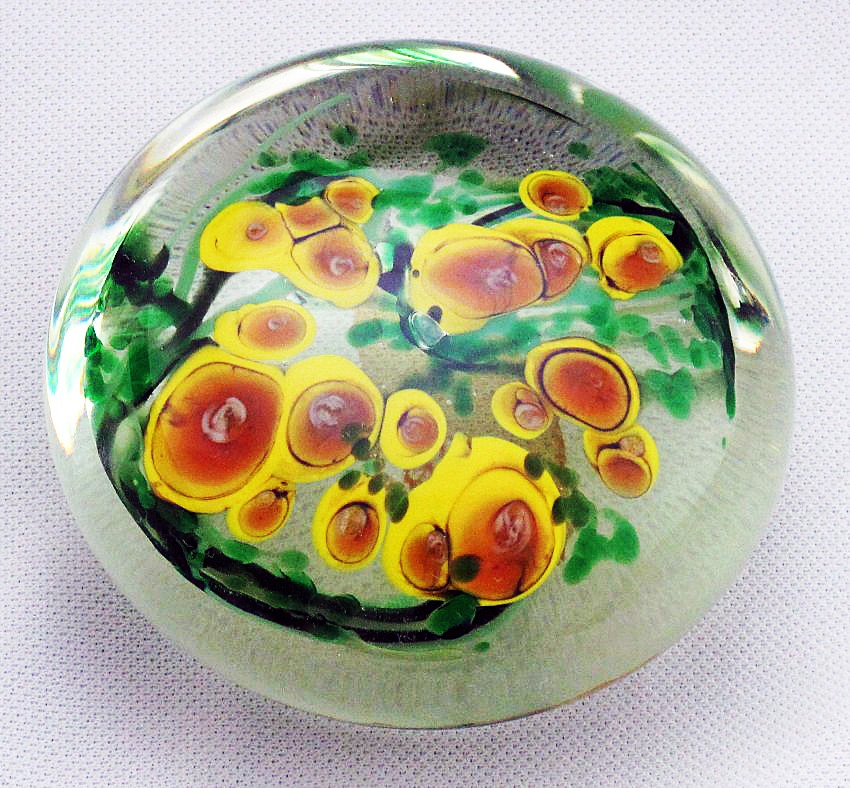Paul Hollister converses with Syvlia Vigiletti about her work at a 1977 paperweight exhibition at Habatat Galleries. Paul Hollister Recording, October 12, 1977. (Rakow title: Habatat Galleries fall show interviews [sound recording] / with Paul Hollister, BIB ID: 168383). Clip length: 06:58. [note: October 12 date stated by Paul Hollister at beginning of recording]
Time stamp: 00:00
Clip 1: Sylvia Vigiletti about the types of objects she makes. Clip length: 01:46.
Paul Hollister (PH): Sylvia Vigiletti, I’m talking to, and these are numbers 341 to 351 and your prices are very, very cheap. They run from 35 to 55 and tell me something about ‘em, what you’re doing, and—
Sylvia Vigiletti (SV): Well, I enjoy making paperweights. It’s not my main type of glass that I do. I do vessels, bottles, mostly decorative items, not functional pieces. And—some of the newer ones that I’ve been doing are these ones that incorporate some lampwork techniques on the piece, but they’re all done mainly with the furnace, not completely over a torch like most the other people—
PH: —where the lampwork just sort of bled into—
SV: Yes.
PH: —into the surface of the thing.
SV: Yes.
PH: You lay it on the surface in some way and it—
SV: Well, I pull threads of colors beforehand and I literally, it’s like drawing on glass with the torch.
PH: And but the things here where you have berries with the spots in the middle—
SV: Mm-hmm.
PH: —sort of other fruits, riper blueberries or whatever they are with the spots. Those all have to be cooked up and made first, and then—
SV: No, they’re just with a thread, I just—with a torch and just touch the glass—
PH: Really? And you get that. Really? This is number 342 that’s quite remarkable. They look like big, ripe blueberries.
SV: Yes. [laughs]
PH: And a little tiny unripe sour ones. The red ones.
SV: Actually, I guess people have commented that my glass looks rather soft, you know, the design.
Time stamp: 01:49
Clip 2: Sylvia Vigiletti discusses the techniques she used to create her pieces on view. Clip length: 02:27.
Paul Hollister (PH): And what about this sort of a pentagonal shape, are those, those are basically, are they rods to begin or they just came up?
Sylvia Vigiletti (SV): No, they happen with—sometimes they occur with a reduction flame of the torch, and those are uncontrollable—as far as I’m concerned, they happen.
PH: But nice. But nice.
SV: But there are—Mark Peiser has a good term to use for this type of thing, and he usually calls things like that gifts, and I think it’s a good way to explain it. It’s something that happens and they’re pleasant, you know, they’re very pleasing with the design.
PH: This is the opaque white ground, which is a sort of a sphere ball shape thing.
SV: Yes.
PH: And it comes right out close to the surface. The design is right up within an eighth of an inch or so near the outer coating, right?
SV: Right.
PH: On most of them. Some of them are further in.
SV: Well, this, yeah. These are—
PH: These are more sculptural.
SV: These have no torch work involved at all, neither do these at the, the end here.
PH: These are more [Dominick] Labino like—
SV: Ah—well, I suppose you could, yeah—I suppose you could call them—
PH: But you’ve used a, you’ve used a pick or something on, some of them haven’t you—on those?
SV: I’ve steamed the inner bubble from the—they’re done in a punty rod, they’re not done on a blowpipe. And so I get a solid piece of glass, then I poke it with a pick, like an ice pick—
PH: Mm-hmm.
SV: —and then I steam it with a little wooden dowel rod that’s sharpened like a pencil and then it blows a bubble.
PH: From above.
SV: And then if I wait long enough till the glass is cold, colder than maybe I normally would—
PH: Yeah.
SV:—gather over it. Then it traps a bubble and I can control it by shaping it. If I want to elongate it becomes a, you know, more teardrop shaped bubble.
PH: This is before your cover it over—
SV: The, yes—
PH: —before you gather again.
SV: Mm-hmm. [pause—voices in background]
PH: That’s most interesting. I love this, this one that looks like the oyster [SV laughs] struggling like mad to give birth to the pearl. But it really does. It really has—that was number 350 which only costs $45 which is very cheap, and it’s a very, very nice shape and it’s an interesting form in there. [voices in background]
Time stamp: 04:19
Clip 3: Paul Hollister inquires with Sylvia Vigiletti about the order in which she made her pieces. Clip length: 02:39.
Paul Hollister (PH): What are you gonna do next, more of the same?
Sylvia Vigiletti (SV): Well, I’m probably going to explore the lampwork technique with the glass a little more. I’m just—that just came about in probably the last three weeks that I’ve been doing that kind of thing.
PH: Why did you do—you did that for this show?
SV: Yeah. Un-huh.
PH: Basically, you would have been doing vases or something else.
SV: I might have been, yes, I, I intermingle, you know, doing paperweights with other things. I don’t—I’m not a production glassblower, so I don’t have—I have the freedom, I think of, you know, like kind of doing what I want to do and presenting it to the public and the gallery or so on, and the work is—the work has usually been very well received, and—
PH: But most of the things you’ve done are vessels or other forms—
SV: Yes.
PH: —than this. Are some of them sort of sculptural, solid forms or is this your first venture really into a big glop of—
SV: No, it’s not really. Probably I’ve done—these are larger paperweight sizes than what I normally do, but sometimes when I do a vessel, it will be fairly thick and not blown out to a large shape, but I use the thickness of the glass for the optical qualities in a design if I feel that it will, you know, enhance the piece, or I can blow it out and have a larger vessel with the same amount of glass.
PH: Yeah. Did you do 347 before you did 346?
SV: Ahhh [thinks]—
PH: Was it a trial run for 346?
SV: I would say 346 was my—was before 347 [laughs]
PH: Really? So, 347 is looser, less naturalistic.
SV: Yeah. I’d say 342 was ahead of 346 [laughs].
PH: Hmm.
SV: I did some blown pieces that were on the thick side with—using the same technique too, and I think the results probably were similar except on the blown pieces I had—I did the layering instead of doing it all on one layer, I did a drawing probably more of the grass part in two or three layers so that it had more dimension to it on the blown pieces.
PH: But these are not, these are not rod pieces, these are furnace pieces.
SV: Yes.
Permalink


